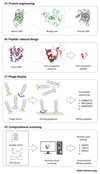Protein- and Peptide-Based Biosensors in Artificial Olfaction
- PMID: 30213453
- PMCID: PMC6245566
- DOI: 10.1016/j.tibtech.2018.07.004
Protein- and Peptide-Based Biosensors in Artificial Olfaction
Abstract
Animals' olfactory systems rely on proteins, olfactory receptors (ORs) and odorant-binding proteins (OBPs), as their native sensing units to detect odours. Recent advances demonstrate that these proteins can also be employed as molecular recognition units in gas-phase biosensors. In addition, the interactions between odorant molecules and ORs or OBPs are a source of inspiration for designing peptides with tunable odorant selectivity. We review recent progress in gas biosensors employing biological units (ORs, OBPs, and peptides) in light of future developments in artificial olfaction, emphasizing examples where biological components have been employed to detect gas-phase analytes.
Keywords: Volatile organic compounds; artificial olfaction; biosensor; odorant-binding protein; olfactory receptor; peptide.
Copyright © 2018 The Authors. Published by Elsevier Ltd.. All rights reserved.
Figures



References
-
- Castelvecchi D. Can we open the black box of AI? Nature. 2016;538:20–23. - PubMed
-
- Wang P, et al. Bioinspired Smell and Taste Sensors. Springer; 2015.
-
- Fitzgerald JE, et al. Artificial nose technology: status and prospects in diagnostics. Trends Biotechnol. 2017;35:33–42. - PubMed
-
- Zhang X, et al. An overview of an artificial nose system. Talanta. 2018;184:93–102. - PubMed
Publication types
MeSH terms
Substances
Grants and funding
LinkOut - more resources
Full Text Sources
Other Literature Sources

